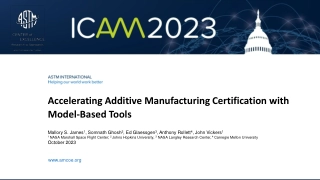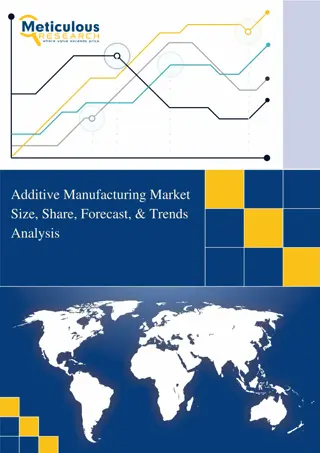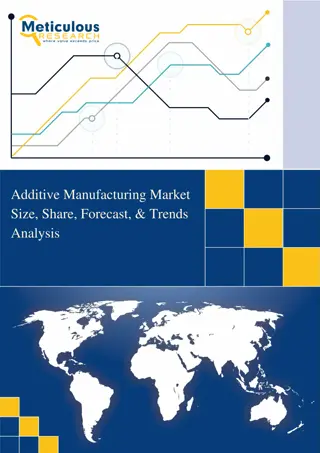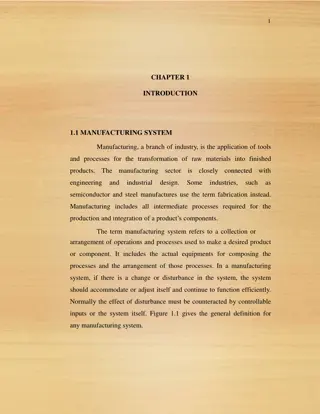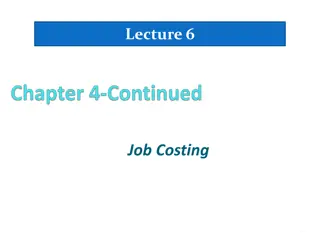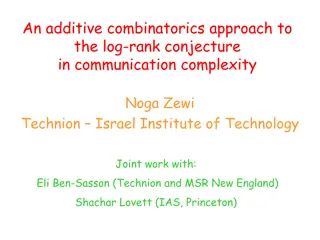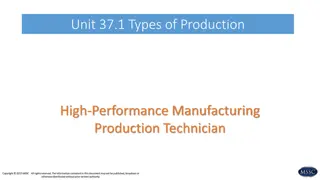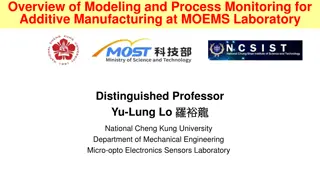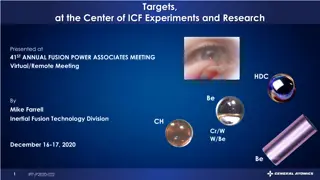Design Complexity in Additive Manufacturing Process Improvement
Product design complexity plays a crucial role in additive manufacturing process optimization. This study explores the impact of geometric intricacy on manufacturing criteria and presents managerial implications for product development. By optimizing design complexity, manufacturers can streamline production, enhance quality, and achieve target performance in additive manufacturing. Key elements of designing for manufacturing are highlighted, emphasizing the importance of simplifying manufacturing processes and improving assembly quality.
Download Presentation

Please find below an Image/Link to download the presentation.
The content on the website is provided AS IS for your information and personal use only. It may not be sold, licensed, or shared on other websites without obtaining consent from the author.If you encounter any issues during the download, it is possible that the publisher has removed the file from their server.
You are allowed to download the files provided on this website for personal or commercial use, subject to the condition that they are used lawfully. All files are the property of their respective owners.
The content on the website is provided AS IS for your information and personal use only. It may not be sold, licensed, or shared on other websites without obtaining consent from the author.
E N D
Presentation Transcript
Design Complexity as a Driver for Additive Manufacturing Process Improvement Nishkal George, Boppana V. Chowdary Department of Mechanical and Manufacturing Engineering University of the West Indies, St. Augustine Campus IConETech-2020, Faculty of Engineering, The UWI, St. Augustine, Trinidad and Tobago
PRESENTATION FORMAT Introduction to Complexity and Design for Manufacturing (DfM) in AM Objectives of the study Methodology Results Design Exploration, Design Optimization Managerial Implications for Product Development Conclusion and Future Work required IConETech-2020, Faculty of Engineering, The UWI, St. Augustine, Trinidad and Tobago
INTRODUCTION Product design describes the process of imagining, creating and iterating products that solve users' problems or address specific needs in a given market (Industrial Designers Society of America 2019). Geometric complexity is an advantage of additive manufacturing but has an associated cost (Durakovic 2018). Complexity can also impact other manufacturing criteria. Target Figure 1. Geometric complexity for manufacturing techniques (Durakovic 2018) IConETech-2020, Faculty of Engineering, The UWI, St. Augustine, Trinidad and Tobago
INTRODUCTION Pradel et al. (2017) proposed a method to quantify design complexity of material extrusion processed parts as an index derived from a combination of cross-sectional design variables. ??? ???? ????= Figure 2. Cross-sectional complex features (Pradel 2017) Fera et al. (2018) utilizes a similar part volume (?????? ? to envelope volume ratio (?????? ??(? ) for shape complexity. ?????? (? ?????? ??(? ? ? = IConETech-2020, Faculty of Engineering, The UWI, St. Augustine, Trinidad and Tobago
INTRODUCTION Optimization has been a critical accelerator in the ability to control and make better decisions in manufacturing: We can optimize Design Complexity to: Stay within manufacturing timeframe or reduce production time Mercedes AMG W10 To simplify manufacturing and assembly To enhance manufacturing quality Design for Manufacturing Manufacturing Criteria Design Tools (DfM) LADA Figure 3. Design for Manufacturing key elements IConETech-2020, Faculty of Engineering, The UWI, St. Augustine, Trinidad and Tobago
OBJECTIVES The objective of the study was to utilize design complexity as an AM performance indicator to: Explore the effects of complex design features on manufacturing. Optimize design features to achieve target performance and manufacturability for AM. Traditionally manufactured product Additively manufactured product Figure 5. AM air filter model Figure 4. Toyota cabin air filter (Wiki 2019) IConETech-2020, Faculty of Engineering, The UWI, St. Augustine, Trinidad and Tobago
METHODOLOGY Figure 6. Design complexity optimization methodology IConETech-2020, Faculty of Engineering, The UWI, St. Augustine, Trinidad and Tobago
METHODOLOGY FCCCD of three manufacturability responses: ?? ?? ?? = ?? ??????? ???? ???? ? = Figure 7. Base air filter design features Factor Symbol Unit Low Centre point (0) High Level (+1) (Design Feature) Level (-1) Wall thickness (WT) Number of Ribs (NR) External fillet (EF) Internal fillet (IF) Rib height (RH) X1 X2 X3 X4 X5 mm count mm mm mm 1.5 2 0 0 3 3.25 3 1.5 1.5 5 5 4 3 3 7 IConETech-2020, Faculty of Engineering, The UWI, St. Augustine, Trinidad and Tobago
DESIGN EXPLORATION Design complexity, CME for Air filter experimental models 0.31 (a) 0.29 Design Complexity, CME 0.27 0.25 0.23 0.21 0.19 1 2 3 4 5 6 7 8 9 1011121314151617181920212223242526272829303132 Experiment No. (b) Figure 9. Design complexity variation Figure 8. (a) Lox complexity model (b) high complexity model IConETech-2020, Faculty of Engineering, The UWI, St. Augustine, Trinidad and Tobago
DESIGN EXPLORATION The Main effects plot for CI shown in Fig. 2, provided a preliminary assessment on the influence of the independent design features on CI and BT. Largest effect : X1, X2 , X5 Smallest effect : X3, X4 (b) (a) Figure 10. Main effects for (a) complexity and (b) build time IConETech-2020, Faculty of Engineering, The UWI, St. Augustine, Trinidad and Tobago
DESIGN OPTIMIZATION Optimal Figure 11. Multi-objective optimization results IConETech-2020, Faculty of Engineering, The UWI, St. Augustine, Trinidad and Tobago
RESULTS OF OPTIMIZATION The method produced an optimized air filter model which for the same amount of material: Was produced in 10% less time and met the manufacturing time criteria of 60 minutes. Had improved accuracy of 0.02 mm when compared to non- optimized model. Production Time 80 60 40 Not Optimized Optimized Figure 13. Production time comparison Figure 12. AM air filter model IConETech-2020, Faculty of Engineering, The UWI, St. Augustine, Trinidad and Tobago
MANAGERIAL IMPLICATIONS Figure 14. Current educational PDD methodology 1. Lack of feedback from QC to design phase until post- manufacturing 2. Lack of feedback from AM production about production time issues such as over time. 3. No production planning consideration during design. IConETech-2020, Faculty of Engineering, The UWI, St. Augustine, Trinidad and Tobago
MANAGERIAL IMPLICATIONS Figure 15. Improved PDD methodology 1. Feedback from QC allows DA to be continuously improved in design. 2. Feedback from AM production about production time issues. 3. Production constraints considered prior to process planning in design phase. IConETech-2020, Faculty of Engineering, The UWI, St. Augustine, Trinidad and Tobago
CONCLUSION The initial challenge addressed in this study is design optimization using design complexity, to achieve target performance and manufacturability. Outcomes: 1. All three investigated responses CI, BT and DA were optimized using the developed method. Further design exploitation through optimization was performed to meet DfM targets. 2. The proposed method successfully improves upon that proposed by Pradel et. al (2017) as it defines the variables of the AM component and fully quantifies the impact of each design feature. IConETech-2020, Faculty of Engineering, The UWI, St. Augustine, Trinidad and Tobago
FUTURE WORK 1. The identification of critical design features in this study, though based on literature, may be described methodically and subsequently improved. 2. Further work is needed to expand this methodology to other AM components and provide a framework for identifying and managing critical design features IConETech-2020, Faculty of Engineering, The UWI, St. Augustine, Trinidad and Tobago
REFERENCES Durakovic, Benjamin. 2018. "Design for additive manufacturing: Benefits, trends and challenges." Periodicals of Engineering and Natural Sciences 6 (2):179-191. Fera, M, R Macchiaroli, F Fruggiero, and A Lambiase. 2018. "A new perspective for production process analysis using additive manufacturing complexity vs production volume." The International Journal of Advanced Manufacturing Technology 95 (1-4):673-685. Pradel, P. , R. Bibb, Z. Zhu, and J. Moultrie. 2017. "Complexity Is Not For Free: The impact of component complexity on additive manufacturing build time." Rapid Design, Prototyping and Manufacturing (RDPM) 2017, Newcastle. What Is Industrial Design? 2020. IDSA. February 26. https://www.idsa.org/what-industrial-design. IConETech-2020, Faculty of Engineering, The UWI, St. Augustine, Trinidad and Tobago
THANK YOU! IConETech-2020, Faculty of Engineering, The UWI, St. Augustine, Trinidad and Tobago


